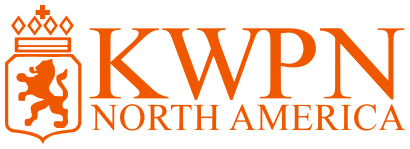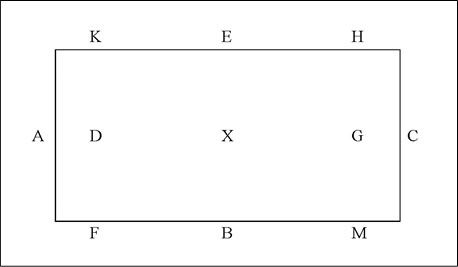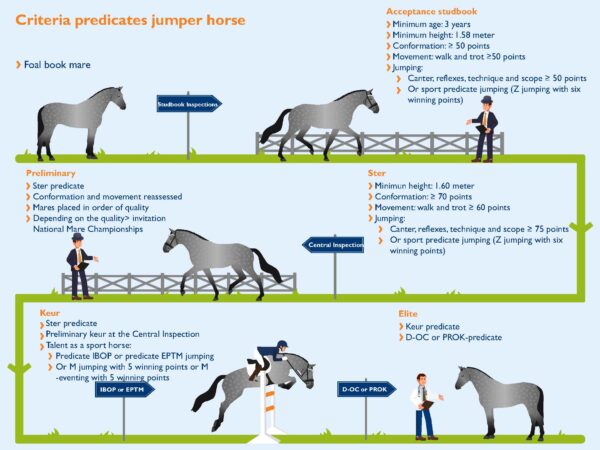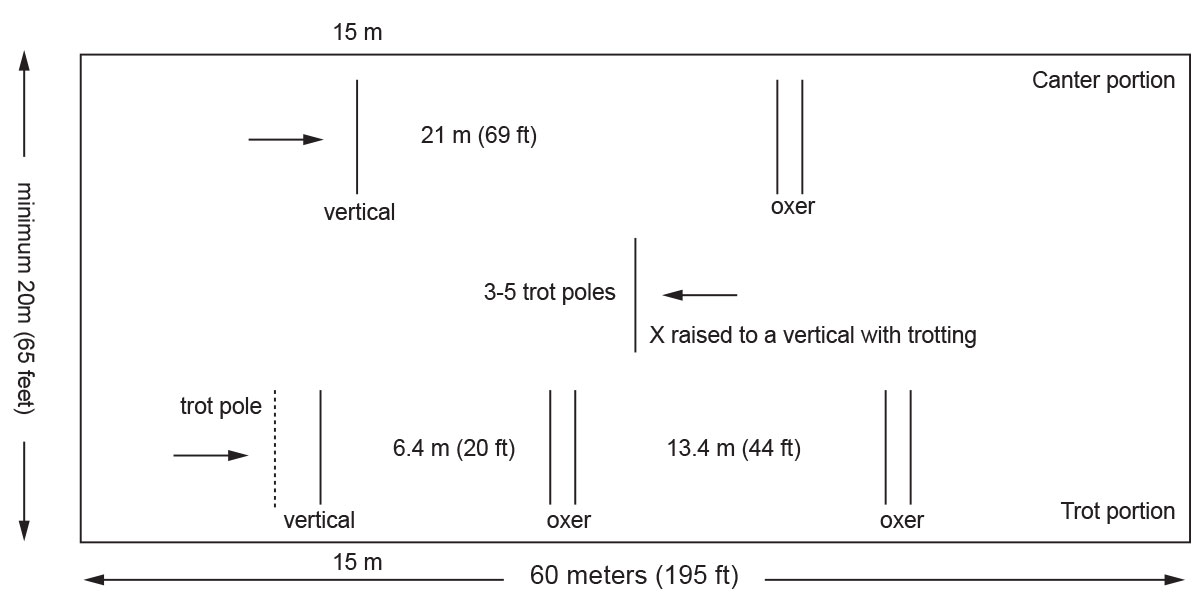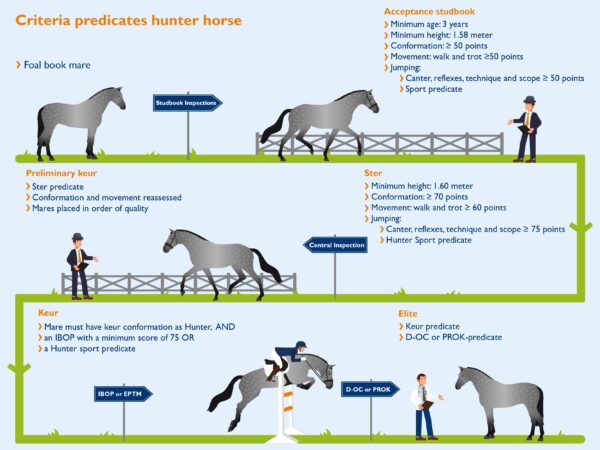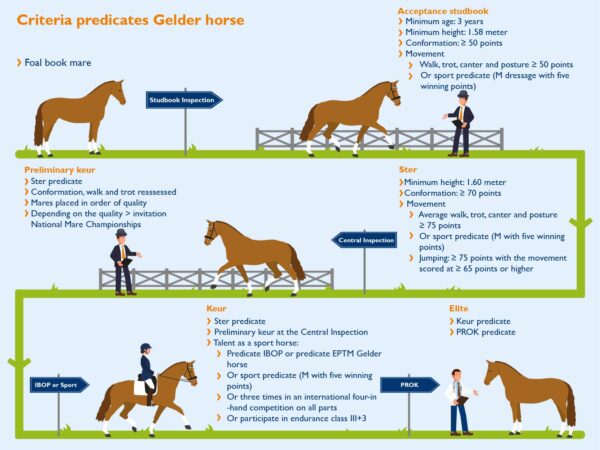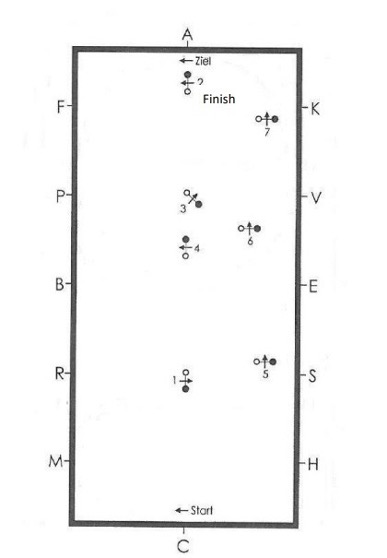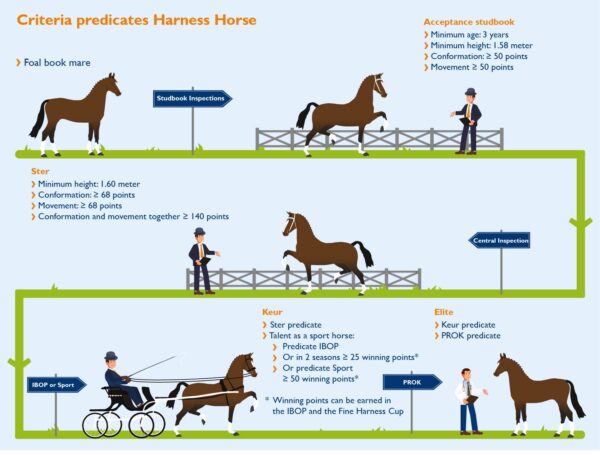Keurings
Keuring Procedures
Premium Grading for Foals, Yearlings and Two-Year-Olds
Young Horse Premiums |
|
|---|---|
| 1st Premium | Exceeds breed standard. Indicator of highest quality. (Is equal to ster status in the studbook inspection.) |
| 2nd Premium | Meets breed standard. Some faults or lack of quality in type, conformation, and/ or movement. (Is equal to studbook status in the studbook inspection.) |
| Elimination | Horses may be eliminated if their conformation or movement precludes them from a first or second premium. |
All young horses are evaluated individually within their breeding direction. First they are individually stood up in front of the jury. Second, they will first walk and then trot in a clockwise direction around the arena. Third, they will again be stood up in front of the jury, facing the other direction.
After all horses in a class are evaluated individually, they all come back as a group in their order of go for a final walk-around. The jury will then place horses, present premiums and give commentary.
No scoresheets filled out for foals, yearlings and two-year-old fillies and geldings. Owners are encouraged to talk to the jury at the keuring. Owners of two-year-old colts in the advice keuring will receive a written report and recommendation.
Foals
A completed birth declaration must be on file with the KWPN-NA office prior keuring entry. It is important for foals to be well prepared for the inspection. Foals should be used to the halter, be able to walk properly on a lead and be easily caught.
Generally foals have not lost all of their foal coat. The jury only examines the quality of the foal and not the coat. Body clipping is not recommended. Clipping the whiskers around the nose and eyes is also discouraged. Clipping the pastern cavities is functional, because it enables the jury to better judge the position of the pastern. The foal’s mane should be braided so the jury can see the line of the neck.
Preferably foals are not weaned because they show much better when presented at the side of their dam. For the individual presentation the mare and foal enter the arena together, each with their own handler.
First, mare and foal are stood up next to each other in front of the jury, with the foal closest to the jury. Second, the foal will be turned loose to follow the mare and her handler around the ring. Third, the foal will be caught and stood up in front of the jury, this time facing the other direction.
Weaned foals are to be shown in-hand only.
When all the foals in a particular breeding direction have been evaluated, the jury will decide the final scores, announce the ringing order and provide commentary for the owner and the public.
The foal’s bridle number must be visible to the jury at all times. Embryo transfer foals should be marked as such on the entry form. If not known the combination might look strange to the jury. Twins should also be marked on the entry form.
Yearlings
Yearlings are shown in-hand as the weaned foals above. Fillies, colts and geldings are in the same class according to breeding direction.
Two-Year-Old Colts, Fillies and Geldings
Two-year-old colts, fillies and geldings in the premium grading class are shown in-hand as the yearlings above.
Two-year-old colts entered in the “Advice Keuring” are presented separately from other two-year-olds. Colts are evaluated as stallion prospects with a pedigree evaluation and linear scoring, including free movement (please note that 2 year olds do NOT free jump, regardless of class). The pedigree approval must be completed in May, prior to entry in this class. See forms page for pedigree approval form.
The goal of this class is to advise breeders on whether the colt meets the criteria for approval and whether or not to present the colt for approval. Owners will receive a written evaluation with jury recommendations or conditions that should be met prior to further presentation. The owner is free to present the horse even if the jury gives negative advice at that particular time.
Successful colts must again undergo the required pedigree evaluation prior to being presented for approval as a three-year-old as well as the veterinary examination according to the approval protocol.
NOTE: Colts that have not completed their pedigree approval cannot enter the advice keuring, but may be premium graded with the other two-year-olds.
Studbook Inspections
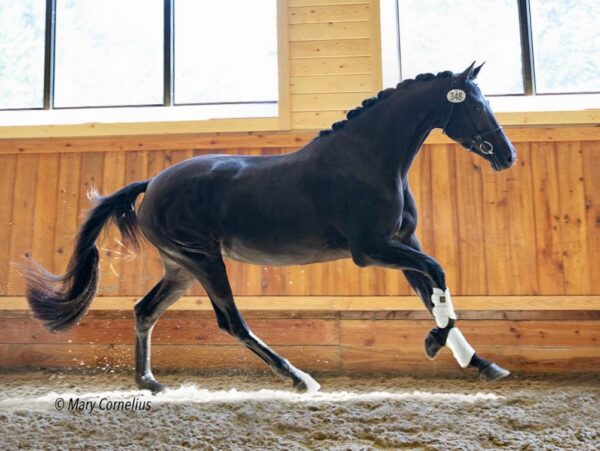
North American Champion Dressage mare: Primrosa S ster keur eligible– 82.5 (80/85) Secret X Juliette d’Rosa S elite IBOP (dr) sport (dr) D-OC By Ampere Owner/ Breeder: Sonnenberg Farm LLC (OR) ©Mary Cornelius
All Riding Type horses (ages three or older) participating in the studbook inspections are evaluated on conformation and free-movement or jumping talent. Harness type horses are evaluated on conformation and in-hand movement. The linear score sheet is used to evaluate both the horse as a whole and its individual traits. This process yields a detailed description of a horse’s traits relative to the KWPN population as well as an overall score for the primary traits of conformation, movement and jumping.
For horses presented for studbook, the ster inspection is part of the class. For mares, the keur eligibility inspection is also part of the class.
Height Requirements
There are minimum height requirements for being accepted into the studbook as well as earning the ster predicate. For all breeding directions the below applies:
Minimum Height for Studbook: 158cm
Minimum Height for Ster: 160cm
Measuring, Markings and Defects
First each horse is individually measured, has its markings checked and is checked for genetic defects.
Hard Surface
Second, each horse is individually walked and trotted in-hand on the hard surface.
Free Movement/Free Jumping
For the third phase, the horse goes to the indoor arena or cage to show off its free movement. Jumpers and hunters will also show their jumping ability. (Horses may wear protective boots on their forelegs during this phase.)
Upon entering the arena, horses should be walked around the perimeter to let them acclimate to the unfamiliar surroundings. The judges will signal when the horse should be let loose, tracking to the right. When the jury has seen sufficient movement and/or jumping for their evaluation, the horse will be caught, walked around the ring one more time and then be stood up in front of the jury. The jury will comment on the horse at this time, after which it will leave the ring.
Dressage
The jury will evaluate the walk, trot and canter in both directions.
** Unless otherwise instructed by the KWPN jury, horses entered in the dressage IBOP will NOT participate in free movement**
Jumper and Hunter
First, the jury will evaluate the trot and canter, in both directions. Next, the jury will evaluate the horse as it is directed through a line of three jumps. All jumps are flanked by rails so horses can’t jump out.
The first jump is a vertical placed six meters from the short side of the ring, with a trotting pole before it.
The second jump is another vertical and placed 6.60 meters after the first.
The third jump is placed 7.10–7.65 meters after the second. It is initially a vertical and later expanded into an oxer, the height of which depends on the age of the horse.
** Unless otherwise instructed by the KWPN jury, horses entered in the jumper or hunter IBOP will NOT free jump**
Harness
Horses are shown in-hand only.
Walk Around
After all horses in a group have completed their individual presentations they will come back as a group for a final walk around, presentation of ribbons and commentary from the jury.
RP and GP ster mares will come back later to be evaluated for keur conformation. TP mares are automatically eligible for keur with their ster rating.
Subsequent Inspections
Representation for Ster
A horse that was accepted into the studbook but that did not earn the ster predicate may be represented for ster if the owner feels that the horse has changed in such a manner to make ster possible in the same breeding direction or will do better in another breeding direction. If switching breeding directions, the horse must first pass an IBOP in the new breeding direction.
Ster Eligible
If a horse receives 70 points for conformation, but not the required 75 points for movement or jumping, the owner has the option to bring the horse back for an IBOP in that same breeding direction. If the horse passes the IBOP it will be awarded with the ster predicate.
Mares may be presented for keur conformation at the same or a later keuring; however, they must pass the IBOP before the conformation class.
Keur Conformation
If a mare is not keur eligible at her studbook inspection, she may be represented for keur in a subsequent year. In the keur conformation class she will join the newly ster mares as they are inspected for keur eligibility.
Mares will be walked and trotted in-hand. The jury will evaluate what they see at that moment and results are not directly relatable to scores from the studbook inspection. If deemed keur eligible, mares must complete the predicate through an IBOP or sport.
The jury will evaluate what they see at that moment and results are not directly relatable to scores from the studbook inspection. If deemed keur eligible, mares must complete the predicate by passing an IBOP or through sport.
Dressage Horse
Keuring, Predicates and IBOP
Upper Beam Movements Scoring
The upper beam movement score for dressage horses consists of separate scores for walk, trot, canter and self-carriage. The overall movement score is the average of those scores. Scoring is on a scale from 40 to 100 points, in increments of five.
- Studbook – A minimum upper beam score of 50 points for conformation and 50 points for movement.
- Ster – A minimum upper beam score of 70 points for conformation and 75 points for movement.
Upper Beam Movement Scoring
| Height | Conformation | Movement | |
| Walk | Trot | Canter | Self- carriage | |||
| Studbook | 158 | Minimum 50 | Minimum average of 50 |
| Ster | 160 | Minimum 70 | Minimum average of 75 |
Studbook and Ster
Horses are shown in-hand on a hard surface and free in an arena or cage. Horses are divided into groups of up to eight horses.
- Each horse is individually presented in-hand on the hard surface; 1) stood up with left side facing the jury, 2) walked away and back in a straight line, 3) trotted away and back in a straight line, and 4) stood up with right side facing the jury.
- Next the group, staying in order, will be shown one at a time in free movement; including trot and canter.
- The group will come back as a whole for a walk around in the ring, presentation of premiums and comments on the horses from the jury.
Free Movement
Free Movement Required
Free movement is required for all horses shown in the dressage breeding direction unless otherwise exempt.
Exemption from Free Movement
A horse may be excused from free movement if the horse has:
- passed a dressage IBOP or EPTM (NL only). Movement scores consist of the scores for gaits and ‘carriage and balance’ from the IBOP or EPTM. If your horse is entered in both the studbook class and the IBOP at the same keuring, they will take the movement scores from the IBOP and the horse will not be required to do free movement.
- a sport predicate in dressage. There will be no upper beam score for movement.
Keur Eligible
After the studbook inspection all ster mares return to the ring and be shown in-hand. Mares will 1) walk around the ring as a group, 2) return one at a time to be shown in-hand at the walk and trot, and 3) return as a group for results and information.
This class is not directly related to the scores in the studbook inspection, but the score of the canter will be taken into account. Being declared ‘keur eligible’ is a step toward earning the keur predicate.
Keur Predicate
- Mare must be keur eligible in the dressage breeding direction or be re-presented for conformation.
- Current IBOP: a minimum of 75 points total, OR
- Performance: a minimum of 1 point at Z1 (L3T1) dressage or 5 points at M (Training) eventing with not more than 10 penalty points.
Sport Predicate
- Minimum of 1 point at Z2 (L3T2) dressage, OR
- Minimum of 5 points at Z eventing (Preliminary).
Dressage IBOP
The dressage IBOP is performed in a small 20 x 60 meter arena
The IBOP consists two parts: an individual dressage-test and a group presentation under saddle in a group of up to three horses. This entails showing the basic gaits as well as a number of tempo changes. Four-year-olds are required to do some leg-yield, and five-year-olds and older must show the shoulder in.
Part 1 – Individual Dressage Test
Someone may call the test. This portion will take about ten minutes.
Part 2 – As a group
After the individual test, horses will come back in groups of up to three horses, grouped by age. The jury will be inside or next to one of the long sides of the ring. A ringmaster will give directions to the riders and the jury will evaluate the horses anew. Part 2 will take about five minutes per horse (ten minutes for two horses, fifteen for three).
Horses are judged on their gaits: walk, trot and canter. In addition, the horse is judged on suppleness, posture and balance, ability to ride, manageability and talent for dressage. The marks for walk, trot and canter count double in the final decision.
Scoring
Maximum score is 100 points, passing score is 75 points
Walk (2x), Trot (2x), Canter (2x), Suppleness, Self-Carriage/Balance, Rideability/Willingness and Talent for Dressage.
A KWPN registered horse that earns 75 points will receive the IBOP predicate. Usually the IBOP is ridden before the studbook inspection and, upon passing, the IBOP will take the place of free movement.
Individual Dressage Test
- A – Enter in working trot – C – Track Left
- H-X-F Change rein working trot
- A – Serpentine with three loops
- Between F and A – Working walk
- K – X – M – Change rein Medium Walk
- Between C and H – Working trot
- E – 20 m circle working trot; before E working canter and continue canter left lead
- B – 20 m circle working canter, lengthening a few strides on the circle
- Between C and H – Working trot
- F – X – H – Change rein medium trot
- B – 20 meter working trot allowing horse to stretch forward and downward Before B Shorten reins
- F – Transition to walk
- K – Transition to working trot
- E – 20-meter circle working trot; before E working canter and continue canter right lead
- B – 20 meter canter right lead, lengthening a few strides on the circle
- Between F and A – Working trot
- K – X – M – Change rein in medium trot
- Between K and A – Transition to working walk
- A – Down center line
- Between X and G – Halt and salute.
Jumper Horse
Keuring, Predicates and IBOP
Upper Beam Movements Scoring
The upper beam score for jumping consists of scores for the canter, reflexes, technique and scope (on a scale from 40 to 100 points, in increments of five). The score for jumping in the upper beam is an average of the scores for canter, reflexes, technique and scope (in increments of five).
Scores for the walk and the trot do not count toward the jumping score; however, they must average at least 50 points to be accepted in the studbook and at least 60 points to receive the ster predicate.
- Studbook – A minimum upper beam score of: 50 points for conformation, 50 points average for walk/trot, and 50 points for jumping.
- Ster – A minimum upper beam score of minimum of: 70 points for conformation, 60 points average for the walk/trot, and 75 points for jumping.
Upper Beam Movement Scoring
| Height | Conformation | Jumping Gaits | Movement | |
| Walk | Trot | Canter | Reflexes Technique | Scope |
|||
| Studbook | 158 | Minimum 50 | Minimum average of 50 | Minimum average of 50 |
| Ster | 160 | Minimum 70 | Minimum average of 60 | Minimum average of 75 |
Studbook and Ster
Horses are shown in-hand on a hard surface and free in an arena or cage. Horses are divided into groups of up to eight horses.
- Each horse is individually presented in-hand on the hard surface; 1) stood up with left side facing the jury, 2) walked away and back in a straight line, 3) trotted away and back in a straight line, and 4) stood up with right side facing the jury.
- Next the group, staying in order, will be shown one at a time in free movement and free jumping.
- The group will come back as a whole for a walk around in the ring, presentation of premiums and comments on the horses from the jury.
Free Jumping
Free Jumping
Free jumping is not required for all horses shown in the jumper and hunter breeding directions. In cases where a horse does the IBOP (Individual Aptitude test) before the studbook inspection then the Free jumping portion of the Studbook class will not be done. (The movement /jumping scores will be taken from the IBOP rather than the free jumping.) As the result is “under saddle”, the movement score is preferred to come from the IBOP test. Nursing mares are allowed to participate in free jumping and/ or IBOPs as long as the foal is not present in the arena (safety).
If a horse does not receive a passing IBOP score then the owner may elect to do the free jumping or free movement in the studbook class.
It is possible for a mare to earn the Keur predicate on the same day that she does her studbook inspection, as long as she is selected for Ster & then Keur eligible. If she then has a passing IBOP score she will become Keur. (She can even become Elite if she already has her PROK/ D-OC predicates.)
The Global Equine Sire Cup (GES Cup) is an additional option for those who would like to enter their 3 and 4 Year olds in a separate free jumping competition.
Exemption from Free Jumping
A horse may be exempt from free jumping if horse has:
- passed a jumping IBOP or EPTM (NL only).
- a sport predicate in jumping, eventing (jumping) or hunters.
There will be no upper beam score for jumping.
Free Jumping Arena
Free jumping evaluations take place in a fenced arena (max. 20 x 40 meters) or in a cage within an arena. Mirrors and reflective surfaces must be covered. First judges evaluate the trot and the canter in both directions. After several rounds, the horse is directed through a line with three jumps built—along a long side. The last jump is adjustable for distance. Poles must be a minimum of three meters in length. Jumps must have safety cups. Only the jury has the right to move or change the jump height and distance.
- 1st jump – cross bar; H 70–80cm
- 2nd jump – vertical; H 80–100cm
- 3rd jump – oxer; H 80–90, 95–100cm
The third jump is initially set up as a vertical and later expanded into an oxer, the height of which depends on the age of the horse in the ring. The maximum height of the oxer for three year olds is 1.20m with a maximum width of 1.00m. Horses are asked to jump the arrangement several times.

Keur Eligible
After the studbook inspection all ster mares return to the ring and are shown in-hand. Mares will 1) walk around the ring as a group, 2) return one at a time to be shown in-hand at the walk and trot, and 3) return as a group for results and information.
This class is not directly related to the scores in the studbook inspection, but the score of the canter will be taken into account. Being declared ‘keur eligible’ is a step toward earning the keur predicate.
Keur Predicate
- Mare must have keur conformation as a jumper AND
- an IBOP with a minimum score of 75, OR
- minimum of 5 points at M level jumping (1.20m or 4′) OR
- 5 points at M Level eventing (Training Level)
Sport Predicate
- Minimum of 6 points at Z level jumping (1.30m or 4’3″), OR
- Minimum of 5 points at Z level eventing (Preliminary Level) with no more than 20 penalty points.
Jumper IBOP Test
Jumper and Hunter horses jump the same course but are judged differently according to type.
Arena Size
20 x 40 meters for warm-up and free jumping. 20 x 50 meters for jumping under saddle and showing of gaits. Jumps must be flanked by rails so horses can’t jump out.
One to three horses of the same age will be in the ring at one time. Horses will take turns jumping one line at a time as designated by the jury.
On the Flat
Horses will enter at the trot and show the trot over ground poles in both directions, including a change of direction, and a few steps of extended trot. Next horses will show the canter in both directions with changes in tempo. The walk will be shown after jumping under saddle (working walk and free walk).
Jumping – At the Trot
- trotting pole and X (vertical) (2x)
- line of trot pole, X (vertical), oxer with one canter stride, oxer with three canter strides
Jumping – At the Canter
- single X (vertical), height dependent on age
- single oxer (rising).
Free Jumping after jumping under saddle (three- and four-year-olds only)
- line of three jumps as described above in ‘Free Jumping.’ Horses that are also in a studbook inspection will jump free only one time, after the IBOP or during linear scoring.
Scoring
Walk and trot are scored but not included in the overall score. The following traits are counted in the evaluation: canter (2x), reflexes (2x), technique (x2), scope, attitude, rideability/willingness and talent for jumping.
Hunter Horse
Keuring, Predicates and IBOP
Upper Beam Movements Scoring
The upper beam score for jumping consists of scores for the canter, reflexes, technique and scope (on a scale from 40 to 100 points, in increments of five). The score for jumping in the upper beam is an average of the scores for canter, reflexes, technique and scope (in increments of five).
Scores for the walk and the trot do not count toward the jumping score; however, they must average at least 50 points to be accepted in the studbook and at least 60 points to receive the ster predicate.
- Studbook – A minimum upper beam score of: 50 points for conformation, 50 points average for walk/trot, and 50 points for jumping.
- Ster – A minimum upper beam score of minimum of: 70 points for conformation, 60 points average for the walk/trot, and 75 points for jumping.
Upper Beam Movement Scoring
| Height | Conformation | Jumping Gaits | Movement | |
| Walk | Trot | Canter | Reflexes Technique | Scope |
|||
| Studbook | 158 | Minimum 50 | Minimum average of 50 | Minimum average of 50 |
| Ster | 160 | Minimum 70 | Minimum average of 60 | Minimum average of 75 |
Studbook and Ster
Horses are shown in-hand on a hard surface and free in an arena or cage. Horses are divided into groups of up to eight horses.
- Each horse is individually presented in-hand on the hard surface; 1) stood up with left side facing the jury, 2) walked away and back in a straight line, 3) trotted away and back in a straight line, and 4) stood up with right side facing the jury.
- Next the group, staying in order, will be shown one at a time in free movement and free jumping.
- The group will come back as a whole for a walk around in the ring, presentation of premiums and comments on the horses from the jury.
Free Jumping
Free Jumping
Free jumping is not required for all horses shown in the jumper and hunter breeding directions. In cases where a horse does the IBOP (Individual Aptitude test) before the studbook inspection then the Free jumping portion of the Studbook class will not be done. (The movement /jumping scores will be taken from the IBOP rather than the free jumping.) As the result is “under saddle”, the movement score is preferred to come from the IBOP test. Nursing mares are allowed to participate in free jumping and/ or IBOPs as long as the foal is not present in the arena (safety).
If a horse does not receive a passing IBOP score then the owner may elect to do the free jumping or free movement in the studbook class.
It is possible for a mare to earn the Keur predicate on the same day that she does her studbook inspection, as long as she is selected for Ster & then Keur eligible. If she then has a passing IBOP score she will become Keur. (She can even become Elite if she already has her PROK/ D-OC predicates.)
The Global Equine Sire Cup (GES Cup) is an additional option for those who would like to enter their 3 and 4 Year olds in a separate free jumping competition.
Exemption from Free Jumping
A horse may be exempt from free jumping if horse has:
- passed a jumping IBOP or EPTM (NL only).
- a sport predicate in jumping, eventing (jumping) or hunters.
There will be no upper beam score for jumping.
Free Jumping Arena
Free jumping evaluations take place in a fenced arena (max. 20 x 40 meters) or in a cage within an arena. Mirrors and reflective surfaces must be covered. First judges evaluate the trot and the canter in both directions. After several rounds, the horse is directed through a line with three jumps built—along a long side. The last jump is adjustable for distance. Poles must be a minimum of three meters in length. Jumps must have safety cups. Only the jury has the right to move or change the jump height and distance.
- 1st jump – cross bar; H 70–80cm
- 2nd jump – vertical; H 80–100cm
- 3rd jump – oxer; H 80–90, 95–100cm
The third jump is initially set up as a vertical and later expanded into an oxer, the height of which depends on the age of the horse in the ring. The maximum height of the oxer for three year olds is 1.20m with a maximum width of 1.00m. Horses are asked to jump the arrangement several times.

Keur Eligible
After the studbook inspection all ster mares return to the ring and are shown in-hand. Mares will 1) walk around the ring as a group, 2) return one at a time to be shown in-hand at the walk and trot, and 3) return as a group for results and information.
This class is not directly related to the scores in the studbook inspection, but the score of the canter will be taken into account. Being declared ‘keur eligible’ is a step toward earning the keur predicate.
Keur Predicate Hunter horse
- Mare must have keur conformation as a hunter, AND
- an IBOP with a minimum score of 75 OR
- Hunter Sports predicate (see below for requirements)
Sport Predicate Hunter horse
- 6 Points in 3’6″+ Hunter divisions (Amateur, Junior and Professional over fences classes) OR
- 12 points in the 3’3″ Hunter divisions (Amateur, Junior and Professional over fences classes) OR
- Earn more than $2,500 in International Hunter Derby Winnings
Hunter IBOP Test
Hunter horses jump the same course during the IBOP and GES cup as Jumpers but are judged differently according to type.
Arena Size
20 x 40 meters for warm-up and free jumping. 20 x 50 meters for jumping under saddle and showing of gaits. Jumps must be flanked by rails so horses can’t jump out.
One to three horses of the same age will be in the ring at one time. Horses will take turns jumping one line at a time as designated by the jury.
On the Flat
Horses will enter at the trot and show the trot over ground poles in both directions, including a change of direction, and a few steps of extended trot. Next horses will show the canter in both directions with changes in tempo. The walk will be shown after jumping under saddle (working walk and free walk).
Jumping – At the Trot
- trotting pole and X (vertical) (2x)
- line of trot pole, X (vertical), oxer with one canter stride, oxer with three canter strides
Jumping – At the Canter
- single X (vertical), height dependent on age
- single oxer (rising).
Free Jumping after jumping under saddle (three- and four-year-olds only)
- line of three jumps as described above in ‘Free Jumping.’ Horses that are also in a studbook inspection will jump free only one time, after the IBOP or during linear scoring.
Scoring
Walk and trot are scored but not included in the overall score. The following traits are counted in the evaluation: canter (2x), reflexes (2x), technique (x2), scope, attitude, rideability/willingness and talent for jumping.
Gelders Horse
Keuring, Predicates and IBOP
Upper Beam Movements Scoring
Gelders horses participating in the stud-book selection are evaluated on conformation, movement and free-jumping (if desired). The upper beam score for movement of a Gelders horse consists of separate scores for walk, trot, canter and self-carriage (on a scale from 40 to 100 points, in increments of five).
- Studbook – A minimum upper beam score of 50 points for conformation and 50 points for movement.
- Ster – A minimum upper beam score of 70 points for conformation according to the Gelders keuring standard with a minimum of 75 points for the average of movement OR 75 for jumping and an average of 60 for movement.
Upper Beam Movement Scoring
| Height | Conformation | Movement | Overall | |
| Studbook | 158 | Minimum 50 | Minimum 50 | |
| Ster | 160 | Minimum 70 | Minimum 75 | A minimum of 75 points for the average of movement OR 75 for jumping and an average of 60 for movement. |
Studbook and Ster
Horses are shown in-hand on a hard surface and free in an arena or cage. Horses are divided into groups of up to eight horses.
- Each horse is individually presented in-hand on the hard surface; 1) stood up with left side facing the jury, 2) walked away and back in a straight line, 3) trotted away and back in a straight line, and 4) stood up with right side facing the jury.
- Next the group, staying in order, will be shown one at a time in free movement; including trot and canter. Free jumping is optional.
- The group will come back as a whole for a walk around in the ring, presentation of premiums and comments on the horses from the jury.
Free Movement/Free Jumping
Free movement is required for all horses shown in the Gelders breeding direction, free jumping is optional.
Keur Eligible
After the studbook inspection, all ster mares return to the ring and be shown in-hand. Mares will 1) walk around the ring as a group, 2) return one at a time to be shown in-hand at the walk and trot, and 3) return as a group for results and information.
This class is not directly related to the scores in the studbook inspection, but the score of the canter will be taken into account. Being declared ‘keur eligible’ is a step toward earning the keur predicate.
Keur Predicate
- Mare must be declared keur eligible in the Gelders breeding direction or be re-presented for conformation. The Keur predicate is earned when the mare has:
- Passed the IBOP – a minimum of 75 points in the under-saddle test or 75 points in the driving test; OR
- Earned her Sports predicate – earned a minimum of M+5 in jumping, dressage or eventing/ drove an international combined driving competition three times in all parts/ participated in endurance class III +3.
Sport Predicate
- Sports predicate – the horse earned a minimum of M+5 in jumping, dressage or eventing/ drove an international combined driving competition three times in all parts/ participated in endurance class III +3.
Gelders IBOP
Gelders horses can choose to be shown under saddle or do a driving test for the IBOP. If shown under saddle, the horse must do both a dressage test and jump over a number of obstacles. If the horse is presented in a driving test, then both the driving- dressage test and the driving skill test is required. The skill test consists of a track with seven obligatory passages with cones.
Note: Stallions must do the riding test or the driving IBOP for their licensing.
Under Saddle
The under saddle test includes both dressage and jumping.
- Dressage points are given for: walk, trot, canter, posture, suitability as a dressage horse
- Jumping points are given for: technique, carefulness, attitude, rideability, suitability as a jumper
All the above-mentioned aspects count 1 time and the total needs to be 75 to pass the IBOP
Jumping Test
Includes jumping under saddle. The height for three- and four-yearold horses is 80cm and may be raised to 115cm upon request of the jury or rider. The height for horses five and older is 90cm and may be raised to 125cm upon request of the jury or rider.
Driving Test
In the driving test horses are judged on the walk (x2), trot (x2), canter, self-carriage, willingness, maneuverability and overall picture in harness (x2). The total possible score is 100 points and the horse needs 75 to pass.
- There is a dressage test and a skill test with cones
- Both tests need to be completed to pass the IBOP
- The skill test with cones has 7 numbered passages that must be passed in order
- The skill test must be done TWICE in a row
- The skill test can be driven in canter or trot, and the driver can use varying speeds in the same test
- The judges can ask the driver to do certain passages again
IBOP Jumping Line & Skill test cones
The current IBOP tests can also be found in the Keuring booklet. or click on the button below.
Gelders Dressage Test
- Start at A in working trot to the left reign (go around multiple times)
- On the long side between H and K lengthen the strides
- Change reigns over the diagonal from H to F and transition to walk
- From K to H lengthen the reigns and let the horse stretch the neck
- On the next short side at C, shorten the reigns again and transition to working trot
- At E make a large circle and transition to canter, after two rounds follow the track
- On the short side, transition back to trot
- Change reigns from K to M
- At B make a large circle and transition to canter, go around twice, in the second circle show several extended canter strides after which you transition back to normal canter and follow the track
- On the following short side, transition back to trot
- At C, make a serpentine with three loops
- At C, make a large circle while letting the horse stretch its neck
- From there, transition into free walk, then follow the track
*End of test *
Harness Horse
Keuring, Predicates and IBOP
Upper Beam Movements Scoring
The upper beam score for Harness horses consists of scores for conformation, movement and general impression. The score for movement has two components: a total score and individual scores for the walk and trot. The scoring scale used for this purpose ranges from 40 to 100 points, marked in five-point increments.
Upper Beam Movement Scoring
| Height | Conformation | Movement | |
| Studbook | 158 | Minimum 50 | Minimum average of 50 |
| Ster | 160 | Minimum 68 | Minimum average 140 overall |
Studbook and Ster
Unlike riding type horses, the Harness type does not participate in free movement.
Horses are shown in-hand on a hard surface and then on the oval in the grass or sand Horses are divided into groups of up to eight horses.
- Each horse is individually presented in-hand on the hard surface; 1) stood up with left side facing the jury, 2) walked away and back in a straight line, 3) trotted away and back in a straight line, and 4) stood up with right side facing the jury.
- Horses are presented in-hand on the oval on grass or sand.
- All horses will come back as a group for a walk around in the ring, presentation of premiums and comments on the horses from the jury.
Register B Mare to Studbook Admittance
Have a Register B Mare and are curious on how the procedure works for them? Check out the chart below. Please note that is for Harness horses only, riding type procedures differ slightly.
Harness horse mares, registered in register B, can participate at keurings for a higher book from the age of three. In the KWPN Selection Rules for mares, foals and geldings, Harness Horse, the exact terms and conditions are explained. Below point wise the general demands:
Register B
- For mares registered in register B, we have the ‘register keuring’. This is a separate section at the keuring. Register B mares can attend, unless their sire is a ‘wachthengst’(is put ‘on hold’) or is disapproved for breeding after judging of the offspring.
- The procedure of the register keuring is equal to that of the normal keuring.
- When a mare registered in register B meets the criteria for admittance in the studbook (stb), and meets the criteria in terms of pedigree/blood*, only then she can be admitted in register A.
Register A
Then the normal procedure for admittance in the studbook of register A mares is in place. This goes as follows. Mares that are admitted in register A, can be definitively be admitted in the studbook (stb) when they meet all the criteria below:
- the mare meets the criteria for the PROK-predicate (see Veterinary rules KWPN)
- the mare has passed the performance test (IBOP) OR
- the mare has met the demands for sports/ performance equal to the keur predicate (see below)
If the sire of the mare has met the veterinary criteria above (recorded with KWPN), the mare does not have to meet that criteria herself. For a stallion, the performance demands counts that the stallion has to have results in the highest sport class for harness horses with the KNHS (Dutch Federation for equestrian sports), or be a proven performance sire in the opinion of the stallion selection committee.
Ster predicate
When the mare has met all the criteria above, she will be admitted in the studbook. When she also meets the criteria for a ster mare, she can be awarded the predicate ‘ster’.
*To be registered in the foalbook (vb) of register A in the breeding direction harness horse, the horse can have a maximum of 75% American Saddlebred and/or Hackney blood (calculated to parents and grandparents).
Keur Eligible
Harness mares become Keur eligible by obtaining the ster predicate. There is no separate inspection for keur conformation.
Keur Predicate
To obtain the Keur predicate:
- Mares must have a ster predicate AND
- pass the IBOP: minimum of 75 points total, OR
- obtain enough Performance points: minimum of 25 winning points at singles competition in 2 seasons, or by reaching the total of 50 winning points (= Sports predicate). Points can be obtained in the IBOP and Fine Harness Cup.
Harness IBOP
STALLIONS: Day 1 will perform the Alternative IBOP. If invited, on Day 2 will perform the Individual Harness Dressage Test and Show Test.
MARES: Day 1 will perform the Alternative IBOP. If invited, on Day 2 will perform Alternative IBOP again.
Driving arena: Minimum 20 x 40 meters.
Equipment required:
- Collar or harness.
- Normal size crupper.
- Shoes may be a maximum of 12mm in thickness, 25mm in width, and must be normally balanced.
- Four-wheel carriage (preferably a show cart).
- The use of aids, like double shoes, tail elevator, check reins and ginger is forbidden.
First, horses will individually complete the IBOP dressage test and second, one or two horses together will do the show test. During the IBOP dressage test, individual horses show their basic gaits and a number of tempo changes. The walk, trot, agility and obedience are evaluated.
Qualifying horses will come back to the arena in pairs for the show test. The following features are judged: front, posture, moment of suspension, action of the front leg, use of the hind leg, willingness to walk and the overall picture as a harness horse. A maximum of 100 points can be obtained, with 75 points needed for a passing score.
Part 1 – Individual Dressage Test
The individual dressage test will be evaluated on the following:
- Walk: scope and suppleness.
- Trot: square, scope, suppleness and self-carriage.
- Maneuverability: correct posture during turns.
- Obedience: positive reaction to the aids and being able to stand still. Results of the dressage test serve as a qualifier for the Show Test and must have a minimum average of six points.
To qualify for the Show test, horses must earn a minimum average of 6 points.
Part 2 – Show test
This is a freestyle with up to two horses in the ring at one time. Horses will enter the arena and halt on the center line between A and C, horses will be inspected by the jury, proceed on the right track and go two times around, change rein, go around two times on the left track and line up on the center line.
Standshow
Go around the arena one time and only be evaluated on the long sides; ask for collection on both long sides and stand up again on the center line. Both horses will proceed on the right track and leave the arena.
Judging the Show Test
- Front (x2)– Use of the head and neck, coming back in the front, self-carriage.
- Posture – Rising in the forehand and sitting in the hindquarter, coming back in the front, relaxation in the topline, posture.
- Suspension – An extended foreleg, engagement of the hindleg, moving with balance without having to develop speed.
- Action of the foreleg (x2) – Action and scope.
- Use of the hindleg (x2) – powerful engagement of the hindleg and flexion of the hock.
- Enthusiasm – Showing happiness and forward motion. Play of the ears and tail.
- General Impression – Overall picture
- Final Score – Grand total of the above-mentioned scores
The above parts will be awarded with a score from 0 to 10 points.
Alternative IBOP
Dressage test:
- Enter in working trot on right lead
- Once around, line up on the center line with the head towards the grandstand / audience and salute
- Inspection by the inspection committee
- Start on right lead in working trot
- After one round change lead across the diagonal
- Show more action in trot over the long side
- Drive a large circle at the middle of the long side
- Transition to walk and change lead across the diagonal
- Transition to working trot and drive a large circle at the middle of the long side
- Show more action in trot over the long side
- Transition to walk
- Line up on the centerline
Show test:
- Start on right lead in show trot
- After two rounds change lead across the diagonal
- After two rounds line up on the centerline
- The inspection committee announces the result
- Round of honor in show trot on right lead, change lead across the diagonal and leave the arena
Individual Harness Dressage Test
- Between A and K enter working trot on right lead.
- A go down center line. X halt and salute.
- Proceed working walk.
- C track right and trot once around.
- After once around, between M and F more action. Between K and H more action.
- Between M and B working walk.
- Between B and F working trot.
- A go down center line. X halt. Proceed working walk.
- G half circle to the left back to X.
- X halt. Proceed walk.
- A track left and trot once around.
- After once around, A large figure eight using entire arena.
- Between F and M more action. Between H and K more action.
- C working walk. A go down center line. X halt and salute.
- Proceed working walk. C track right.
- M change direction. Between A and F leave arena.

